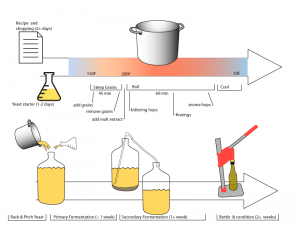October’s Fermentation Friday is hosted by Pfiff. The topic is:
It’s time for y’all to whip out your best homebrewing horror stories. Extra points for tales of woe told in true campfire fashion, and head straight to the front of the class for a bonus handful of candy corn if there’s a deliciously ironic twist in the end.
Well, gather ’round because I have one of the most frightening, lurid tales. Deep in the dark basement is where I store my homebrewing equipment, right next to the crawl space. In fact, there are some small holes in the partition between the safe part of the basement, and the dark, dusty, and recently-radon infested crawl space. One night recently, I wandered down in the dark to check on the laundry when I noticed a dulled sheen on my brew kettle nestled beneath the open stairs. Normally it sparkles in its stainless glory. Something was wrong.
I stepped closer, straddling the pile of towels and linens waiting to wash, and was mortified to discover the cause. A layer of dust and dog hair had settled on top of my equipment, all of it. The equipment hadn’t been used for so long that had not only it developed a cake of dust, but it had started growing hair.
Oh torment! Have I been such a neglectful homebrewer that my equipment is evolving in a Lamarkian rate to find a meaningfun existance? I leaned in close to the kettle, whispered in it’s ball-valve “I’ll brew again! Just don’t leave! I’ll stop buying all the Full Sail Doppelbocks at New Seasons!”
Then, I traced a finger over the lid, hoping to soothe it, and was relieved to find that the dust and hair came up on the tip of my finger. This wasn’t permanent at all, just a dusting of neglect, a sin I could redeem myself of.
